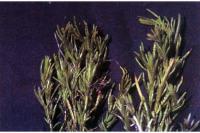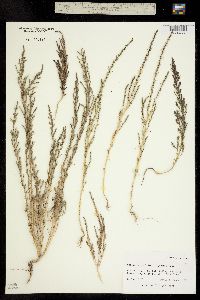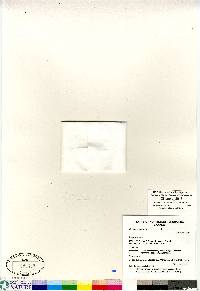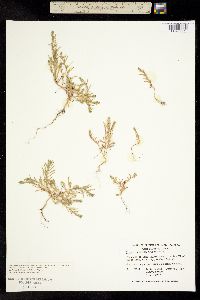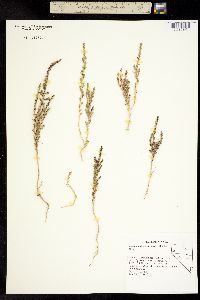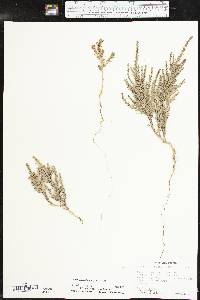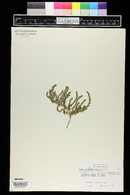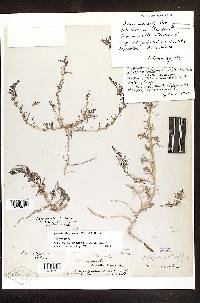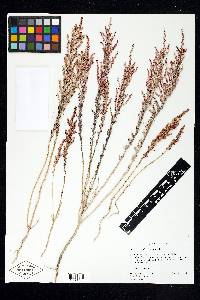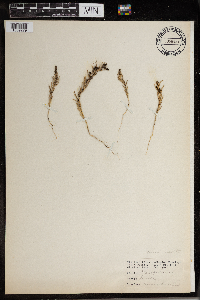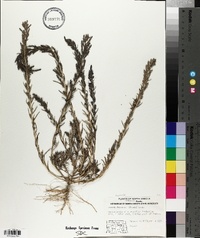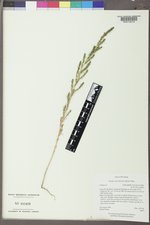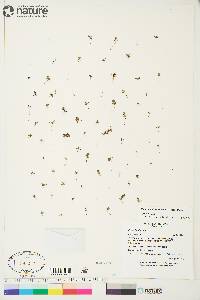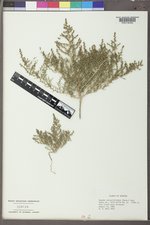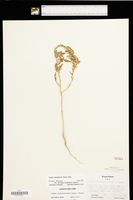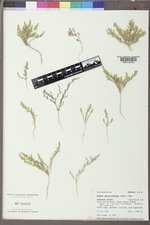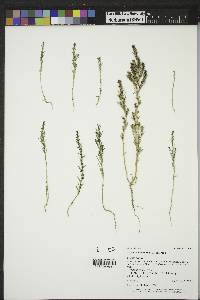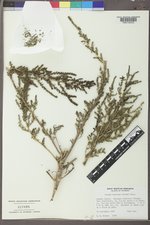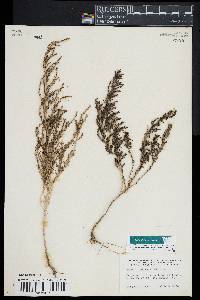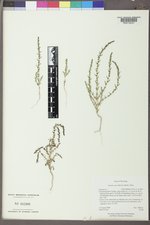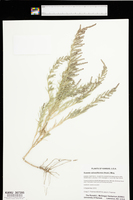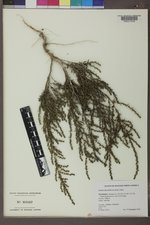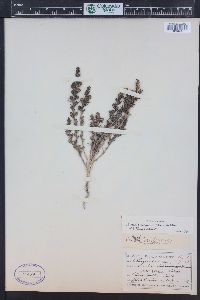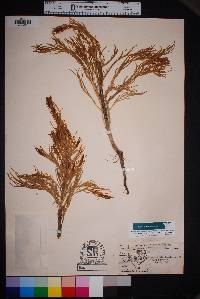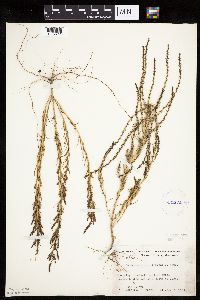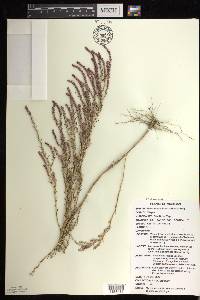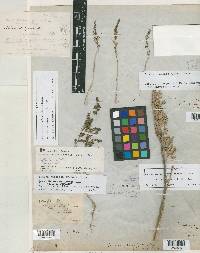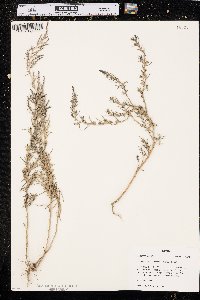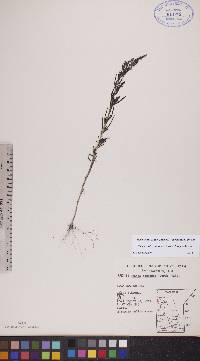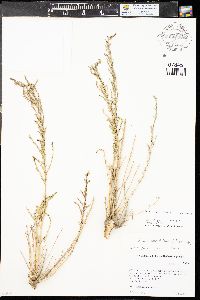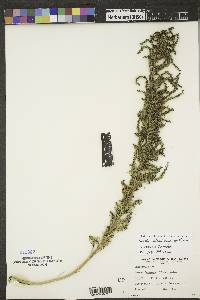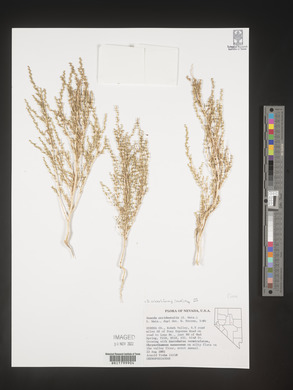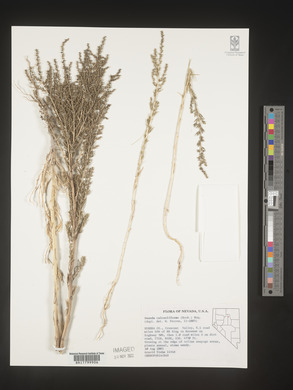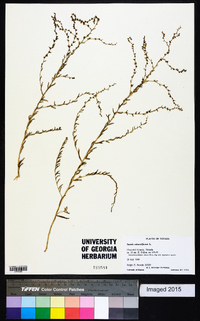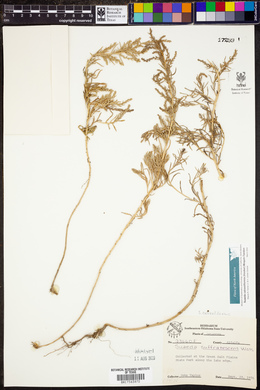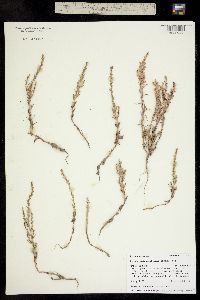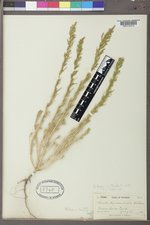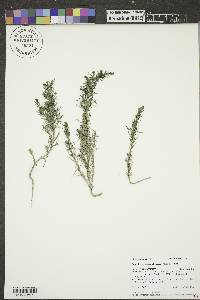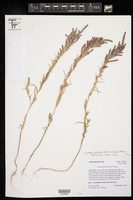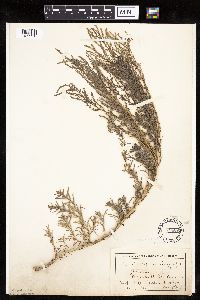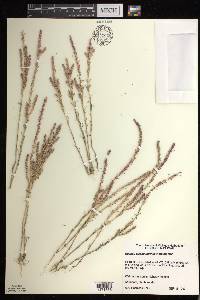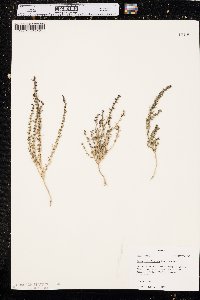
|
|
|
|
Family: Amaranthaceae
Paiuteweed
[Chenopodina depressa (Pursh) Moq., moreChenopodium calceoliforme Hook., Chenopodium conardii A. Nelson, Dondia americana (Pers.) Britton, Dondia depressa auct. non (Pursh) Britt., Schoberia occidentalis S. Wats., Suaeda americana (Pers.) Fern., Suaeda depressa auct. non (Pursh) S. Wats., Suaeda depressa var. depressa , Suaeda depressa var. erecta S. Wats., Suaeda erecta , Suaeda maritima var. americana (Pers.) Boivin, Suaeda minutiflora S. Wats.] |
Herbs, annual, prostrate to erect, green to dark red, 0.5-8(-10) dm, glaucous. Stems decumbent to erect, green to dark red, usually striped, simple or branched; branches decumbent, ascending, or spreading. Leaves often tightly ascending, sometimes ± spreading; blade linear-lanceolate, adaxial surface flat, (5-)10-40 × 0.2-15 mm, usually widest proximal to middle, apex acute to apiculate. Glomes usually crowded in 1-6 cm compound spikes, 3-5(-7)-flowered; bracts subtending branches leaflike, often slightly broader than leaves, bracts subtending glome similar in shape to leaves, 2-12 × 0.8-1.5 mm, broadest proximal to middle, thin-margined basally. Flowers bisexual; perianth zygomorphic or irregular (1 or 3 segments usually larger), 1-4 mm diam.; perianth segments transversely winged proximally (continuously in disk or interrupted), rounded and keeled abaxially and/or horned or hooded distally; stigmas usually 2. Seeds dimorphic; lenticular, 0.8-1.7 mm diam., with seed coat black, shiny; or flat, 1-1.5 mm diam., with seed coat brown, dull. 2n = 36. Flowering summer-fall. Saline or alkaline wetland soils, including disturbed areas and reservoir margins, also along salted roadsides; 0-2400 m; Alta., B.C., Man., N.B., Nfld. and Labr. (Nfld.), N.W.T., N.S., Nunavut, Ont., P.E.I., Que., Sask., Yukon; Alaska, Ariz., Calif., Colo., Conn., Idaho, Ill., Ind., Iowa, Kans., Maine, Mass., Mich., Minn., Mo., Mont., Nebr., Nev., N.H., N.J., N.Mex., N.Y., N.Dak., Okla., Oreg., R.I., S.Dak., Tex., Utah, Wash., Wis., Wyo.; Mexico. The name Suaeda depressa has been misapplied to this species (J. McNeill et al. 1977). In the northeastern part of its range, S. calceoliformis was long known as S. americana, but the two were found to be conspecific (I. J. Bassett and C. W. Crompton 1978). Suaeda calceoliformis can easily be confused with S. occidentalis, with which it is sympatric in the Great Basin; see comments under S. occidentalis. Plants of the annual Mexican seepweed, S. mexicana (Standley) Standley also are similar to S. calceoliformis, but are more or less shiny, yellowish or light brown, and have opposite leaves at the base and alternate ones distally. Suaeda mexicana has been reported once (in 1895) from El Paso County, Texas, but no specimens have been located to substantiate the report.
Annual herb 5 cm - 1 m tall Stem: decumbent to upright, unbranched or branched, green to dark red, often striped, with a waxy coating (glaucous). Leaves: alternate, ascending, sometimes more or less spreading, 1 - 4 cm long, to 1.5 cm wide, narrowly lance-shaped with a pointed tip, fleshy. Inflorescence: a cluster of three to five flowers (glome), which together form crowded, 1 - 6 cm long, compound spikes. The glomes are subtended by bracts which are shaped like the leaves. Flowers: bilaterally symmetrical or irregular, greenish, 1 - 4 mm wide, with five distinct, differently shaped sepals and no petals. Sepals transversely winged near the base, keeled and rounded below and/or with a hood at the tip. Stamens five, exserted. Stigmas two. Fruit: one-seeded (utricle), enclosed in the persistent sepals, 1.5 - 2 mm wide. Wall (pericarp) not adherent to the seed, membranous. Seeds black, shiny, 0.8 - 1.7 mm wide, and lenticular (lens-shaped) or brown, dull, 1 - 1.5 mm wide, and flat. Similar species: No information at this time. Flowering: late June to late September Habitat and ecology: Introduced from farther west. Frequent along expressways where salting occurs during the winter. Occurence in the Chicago region: non-native Etymology: Suaeda comes from the Arabic word for this plant. Author: The Morton Arboretum FNA 2004, Jepson 2012, Kearney and Peebles 1969, McDougall 1972, Allred and Ivey 2012 Duration: Annual Nativity: Native Lifeform: Subshrub General: Annual herbs, to 1 m tall; stems prostrate, decumbent, or erect; simple or branched; the branches decumbent, ascending, or spreading; surfaces green to dark red, glaucous, usually striped. Leaves: Opposite or sometimes alternate, sessile to short-petiolate; blades linear-lanceolate, fleshy, subterete, 5-40 mm long and up to 2 mm wide, often tightly ascending, sometimes spreading. Flowers: Small and inconspicuous, reddish-green, in small axial clusters, these subtended by leaflike bracts and arranged in compound spikes, 1-6 cm long; flowers bisexual, barely 2 mm wide; perianth zygomorphic. Fruits: Seeds lenticular, shiny black or dull brown, 1 mm wide. Ecology: Found in saline or alkaline wetland soils, including disturbed areas and reservoir margins, also along salted roadsides, below 8,000 ft (2438 m); flowers summer-fall. Distribution: AK to MI, south to TX, NM, AZ, CA, and MEX; disjunct on the New England coast. Notes: This is the annual Suaeda found in Arizona and New Mexico. There is some question as to the naming of this species. The currently accepted name by FNA and Tropicos is Suaeda calceoliformis (Hook.) Moq. However, it goes by Suaeda depressa in many texts. Kearney and Peebles note that these plants are moderate to excessive indicators of soil salinity, and that the plants are sometimes browsed when other other feed is scarce. Ethnobotany: Seeds used for food by several tribes. Etymology: Suaeda is an Arabic name of this plant, and depressa means appearing to be pressed down flat. Synonyms: Suaeda calceoliformis, Suaeda plattensis, Schoberia calceoliformis, Salsola depressa, Lerchea calceoliformis, Dondia depressa, Chenopodium calceoliforme, Chenopodina depressa Editor: LCrumbacher2012, AHazelton 2015 Erect to decumbent, 1-8 dm; lvs green or glaucous, plano-convex, widest at the base, the primary ones to 4 cm, those of the branches much shorter; spikes usually dense; bracts lance-ovate, 2-6 mm; evidently broader than the foliage lvs; cal at maturity 1.5-2 mm, irregular, 1-3 sep strongly hooded, the others less so or merely carinate; seeds 1-1.5 mm wide; tetraploid, 2n=36, 54. Saline or alkaline soil; B.C. and s. Yukon to Calif., e. to Sask., w. Minn., and Tex., and occasionally intr. eastward, as in n. Ill. and s. Mich. (S. depressa and Dondia depressa, misapplied; S. erecta) S. rolandii Bassett & Crompton, from N.B., N.S., and Que., may be distinct; lvs not wide-based; seeds dimorphic, 1.5-2 mm; 2n=90. Gleason, Henry A. & Cronquist, Arthur J. 1991. Manual of vascular plants of northeastern United States and adjacent Canada. lxxv + 910 pp. ©The New York Botanical Garden. All rights reserved. Used by permission. From Flora of Indiana (1940) by Charles C. Deam Indiana Coefficient of Conservatism: C = null, non-native Wetland Indicator Status: FACW Diagnostic Traits: plant of saline habitats; leaves alternate, fleshy, not spine-tipped; flowers sessile in axiles of leaves or leafy bracts; calyx 5-parted, enclosing the fruit, wingless. |
This project was made possible in part by the Institute of Museum and Library Services [MG-70-19-0057-19].
Powered by Symbiota


